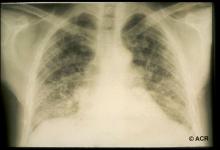Fatigue Looms Large in Lupus Save

Fatigue is an important component of the disease experience in systemic lupus erythematosus (SLE), and can have a profound impact on patients' perception of well-being, Italian researchers reported.
Median scores on the Functional Assessment Chronic Illness Therapy (FACIT)-fatigue scale were 40 in a cohort of SLE patients compared with 47 among matched healthy controls (P<0.001), according to the study by Marta Mosca, MD, PhD, and colleagues from the University of Pisa.
And while FACIT-fatigue scores showed no correlation with SLE disease activity, a strong negative correlation was seen between FACIT-fatigue scores and scores on the multifaceted Lupus Impact Tracker (LIT), which measures pain, the impact of fatigue, cognition, and physical/emotional health (r = -0.78, P<0.001), the researchers reported online in RMD Open: Rheumatic & Musculoskeletal Diseases.
This inverse correlation between FACIT-fatigue and LIT "is of particular interest," the team wrote. "Patients with higher levels of fatigue manifested a greater perception of SLE impact. This underlines the fact that fatigue contributes significantly to the determination of disease burden in a patient's daily living."
Despite the major advances seen in recent decades in the treatment of SLE, health-related quality of life remains poor in many patients. This can be due to multiple factors such as disease manifestations, fatigue, organ damage, comorbidities, psychosocial, behavioral, and socioeconomic factors. More than half of patients complain of fatigue, and previous studies have indicated that fatigue is a major reason for loss of work and productivity among patients.
Yet the relationship between fatigue, disease activity, and health-related quality of life in SLE is little understood, so Mosca and colleagues conducted a cross-sectional study of 223 patients enrolled in the university's rheumatology clinic from 2017 to 2018.
Participants' mean age was 45, more than 90% were women, and almost all were Caucasian. Median disease duration was 13 years.
Median score on the Systemic Lupus Erythematosus Disease Activity Index (SLEDAI) was 2, but 18.2% of patients had scores above 4 and were considered as having active disease. A total of 49.3% had damage scores above zero, with a median score of 2, and 11.8% had a concomitant diagnosis of fibromyalgia.
Disease manifestations included articular involvement in 16.1%, hematologic in 14.8%, and cutaneous in 12.1%.
Two-thirds of patients were receiving hydroxychloroquine, more than half were on low-dose daily steroids, and 45% were receiving conventional disease-modifying antirheumatic drugs. Fewer than 10% were on biologics such as belimumab (Benlysta).
Patients were divided into four groups according to disease activity:
- Low disease activity was defined as a SLEDAI of 4 or lower, with no activity in major organs, a physician global assessment of 1 or lower, and low doses of prednisone and standard maintenance doses of immunosuppressive or biologic drugs. A total of 14.8% of patients in the cohort were classified as having low disease activity
- Clinical remission required a SLEDAI of zero and physician global assessment below 0.5; clinical remission was further subdivided into remission on treatment (43.5% of patients in the study) and remission off treatment (20.2%)
- The remaining patients in the study were classified as having active disease
When the researchers considered the impact of disease activity on fatigue, they found no difference in FACIT-fatigue scores according to disease activity category. Median FACIT scores were:
- 36 for patients in active disease
- 39 for those in low disease activity
- 40 for those in remission on treatment
- 44.5 for those in remission off treatment
Moreover, no differences in FACIT-fatigue scores were seen according to patient age and duration of disease, organ involvement, or type of treatment being given. However, significantly worse fatigue scores were seen in the subgroup of patients who had concomitant fibromyalgia.
Correlations were also seen on patient-reported outcomes other than the FACIT and LIT. On the Short Form-36 measure of health-related quality of life, which includes physical function, mental health, social functioning, and vitality, strong positive correlations were seen for all domains (r = 0.53 to 0.77, P<0.001), with the greatest correlation on the vitality domain (r = 0.77).
A negative correlation was seen on the Brief Index of Lupus Damage, which represents a self-evaluation of disease damage (r = -0.28, P<0.01). And on the Systemic Lupus Activity Questionnaire (SLAQ), which represents patient self-evaluation of disease activity, a negative correlation was seen (r = -0.72, P<0.001), "as patients with more severe fatigue perceived their disease as being more active," the researchers noted.
This negative correlation between FACIT-fatigue and SLAQ "suggests that fatigue represents a puzzling factor in the complex clinical picture of patients with SLE, which leads them to overestimate SLE activity and severity and therefore become dissatisfied with the care process and health status," Mosca and co-authors wrote.
"In conclusion, fatigue appears as an extremely frequent and pervasive symptom in patients with SLE, even for those in remission or in low disease activity, and therefore deserves greater consideration in routine clinical care," the researchers stated.
A limitation of the study, they said, was that certain additional factors such as mood disorders were not included in the analysis.







If you are a health practitioner, you may Login/Register to comment.
Due to the nature of these comment forums, only health practitioners are allowed to comment at this time.